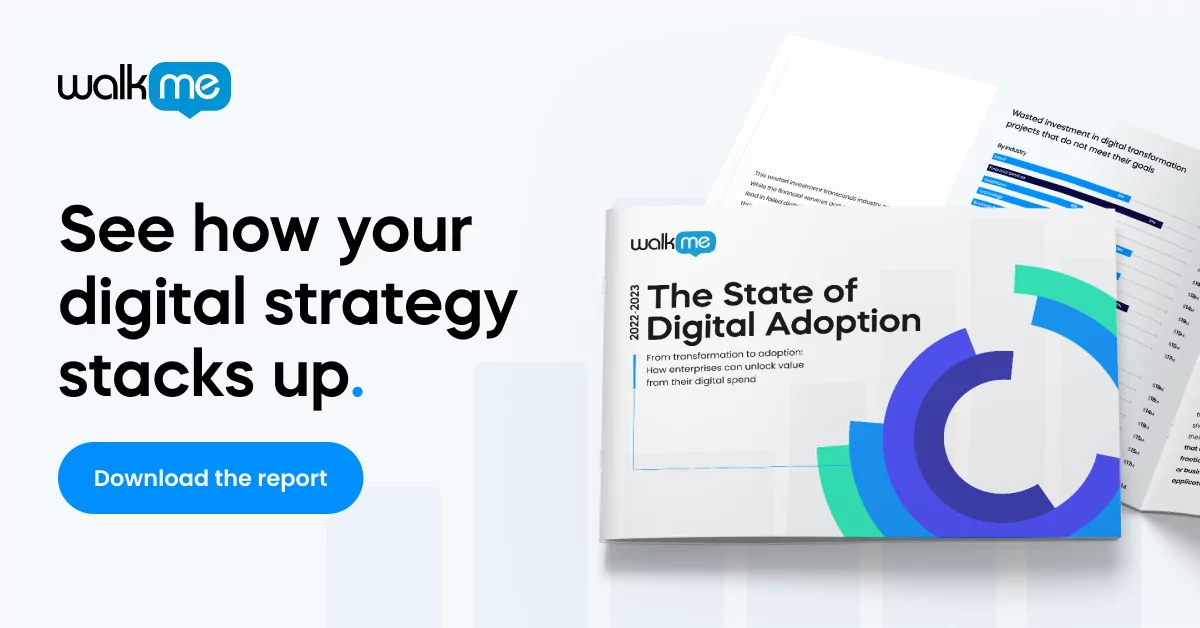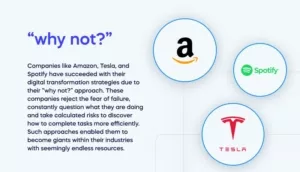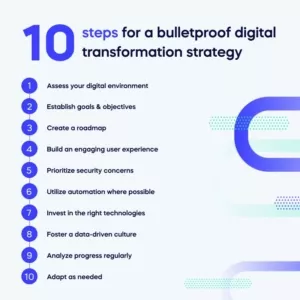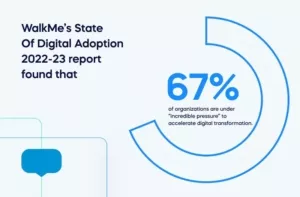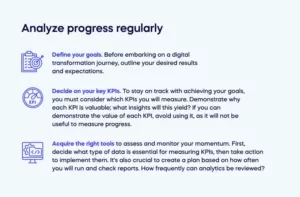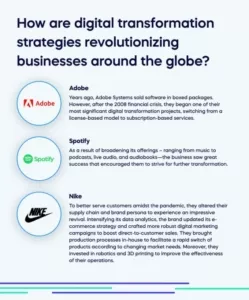In today’s age of constant technological advancement, digital transformation is essential for sustaining steady growth and remaining competitive. Worldwide IT spending is expected to grow 2.4% in 2023 to nearly $US 5 billion, but uncertain market conditions and geo-political pressure presents considerable challenges to global organizations.
To help you address the challenges of building a digital transformation strategy today, we have detailed the key steps and best practices to help you develop a successful digital transformation strategy from the ground up. Let’s begin with a definition.
What is a digital transformation strategy?
An effective digital transformation strategy is essential for corporations today. It allows them to leverage the power of digital technology to increase efficiency and collaboration, improve business outcomes, and provide the best user experience.
However, successfully digitizing an enterprise involves more than deploying new technologies or transitioning to a cloud-based platform; it requires a significant shift within its culture, processes & workflows. People, not technology, drive a successful digital transformation strategy.
Why digital transformation strategy is important
A digital transformation strategy is important in today’s world because it allows businesses to keep up with the ever-changing technological landscape. By embracing digital technologies and transforming their operations, companies can gain a competitive edge and stay relevant in their industry. Digital transformation helps businesses improve customer experience, reduce costs, increase efficiency and enable faster innovation.
Companies like Amazon, Tesla, and Spotify have succeeded with their digital transformation strategies due to their “why not?” approach. These companies reject the fear of failure, constantly question what they are doing and take calculated risks to discover how to complete tasks more efficiently. Such approaches enabled them to become giants within their industries with seemingly endless resources.
This process begins by looking at the size – as our world evolves digitally, all sizes of organizations must evolve as well, even in the face of unexpected circumstances. WalkMe’s State Of Digital Adoption 2022-23 report found that 67% of organizations are under “incredible pressure” to accelerate digital transformation.
Digital transformation goes beyond adding new technologies to a company’s tech stack. Now, enterprises are using digital technologies to uncover potential inefficiencies and opportunities to scale their impact.
For companies to remain competitive, they must approach a digital transformation strategically and leverage the right tools. These technologies can be used to identify employee needs in the present and predict potential issues team members may encounter in the future.
10 steps for a bulletproof digital transformation strategy
Follow our ten steps for a bulletproof digital transformation strategy to help you create the most cost-effective and efficient digital transformation strategy.
1. Assess your digital environment
Examine the technologies you currently use and the functions they fill, then identify gaps and focus on what matters most for your organization. You can then use this information to select new technology that can satisfy those needs. Doing so will increase efficiency and create an optimized user experience.
Following a structured process to assess your digital environment as you build your digital transformation strategy is important. That way, when you make purchases, you avoid adding to the 62% of technology purchases that did not fulfill expectations that a leading research firm discovered in their research.
Ask yourself these questions to determine your current technology use and identify gaps before investing in any new technology. Do you need to:
- Optimize standard processes and workflows for greater efficiency?
- Forge collaborations with clients and include them in your work process?
- Estimate your time and budget to make more informed decisions?
- Streamline your customer’s information and automate workflows?
Finally, choosing the right technology that will not only fit your ambitions but also help you achieve them is essential.
2. Establish goals & objectives
A digital transformation journey is about showing employees the immense potential of unlocking new ways of working, not intimidating them with new technology for which they don’t understand the purpose. Having clear objectives and goals helps give your organization a clear sense of purpose and enables you to monitor progress to ensure you’re on track for success.
WalkMe research (State of Digital Adoption 2022-2023) shows that, in 2021, enterprises incurred additional costs of almost $US 100 million, partly due to the unexpected costs of meeting goals. These costs may have been avoided if these organizations had established more robust goals earlier in the process.
There are many types of goals that you may find helpful as starting points, such as:
- Increase revenue
- Adopt greater agility
- Optimize collaboration
- Reduce software costs
- Gain competitive advantage
- Boost employee productivity
- Improve customer experience
- Increase governance and compliance
3. Create a roadmap
Organizations can create a digital transformation roadmap to navigate their journey from outdated digital processes to more advanced ones. To build an effective strategy, you must understand your business needs and identify any weaknesses in your current system. Additionally, setting achievable timeframes along with measurable milestones and checkpoints is essential for identifying success or failure down the line.
Split your digital transformation strategy roadmap into three sections to meet all your business needs: operating and business models, user experience, and operational processes.
Business models
Empowering new business models opens the door to numerous prospects – from building innovative products attracting customers, and finally providing value.
User experience
In today’s user-centric, digital world, users expect to get what they need when they need it. An exceptional user experience is critical for businesses looking to stay competitive and meet these expectations.
Operational processes
Integrating digital technology into a business is one of the critical objectives in digital transformation as it revolutionizes how a company operates and provides value to its customers.
4. Build an engaging user experience
An engaging user experience (UX) is essential for successful digital transformation strategy creation. You cannot expect users to stay loyal to your products and services if you do not offer them the most accessible, engaging experience when they view and utilize what you offer.
An updated UX shows users that you always keep their experience and services fresh, stimulating, and current while presenting your company-wide strategic vision to new and existing users.
5. Prioritize security concerns
“In 2021, the FBI received the highest number of cybercrime complaints and reported total losses in history—nearly 850,000 complaints reflecting more than $6.9 billion in losses. The preceding four years averaged about 480,000 complaints with roughly $2.95 billion in yearly losses.”
While building and implementing your digital transformation strategy, you may ignore security concerns, which could potentially lose you money and clients and cause long-term damage to your company’s reputation.
Prioritize security concerns by ensuring your security covers three categories: Information security, network security, and cybersecurity.
Information security
To ensure data safety, implement information security management initiatives by following protocols from the ISO/IEC 27000 standards. Such efforts guarantee that confidential documents remain private, trustworthy, and available when needed.
Network security
Network security management is an essential element of network strategy. Networking is the bridge from which cyber threats can enter the system, thus making it a critical component in defending against malicious agents.
Cybersecurity
Cybersecurity management is a holistic approach to shielding an organization’s IT assets from malicious cyber threats. This type of security management requires safeguarding the network, cloud infrastructure, mobile devices, Internet of Things (IoT) components, and applications/APIs that form part of an organization’s IT systems.
6. Utilize automation where possible
If digital transformation is indeed a journey, organizations and leaders should ask themselves: What do we do when we reach the destination? Automation plays an essential role in answering this question.
When your company achieves digital transformation goals, automation allows you to design new services, products, and data streams. These extra tasks would otherwise be challenging for teams to manage manually. In short, automation is the foundation that helps digital transformation initiatives leave lasting impressions after their initial successes.
7. Invest in the right technologies
Although people are at the heart of a successful digital transformation strategy, technology partners with users to deliver results, making it crucial to ensure you invest in the right technologies for your goals.
Do you want to increase your customer experience? Invest in a custom CRM, providing you with automation tools that focus on efficiency, allowing your employees to focus on more complex tasks.
Whatever you focus on, remember that your staff must be able to use new technologies, so explain to them the purpose of the technologies before ordering, offer time for them to ask questions, and provide adequate training to optimize ROI and reduce employee churn.
8. Foster a data-driven culture
Fostering a data-driven culture as part of your digital transformation strategy has many benefits because data is critical to success in today’s technology and consumer-driven marketplace. When you foster a data-driven culture, you optimize data quality, maintain high data analysis standards and ensure that you measure every cost for optimal ROI.
9. Analyze progress regularly
The nature of digital transformation is rooted in change. This point shows us why you must regularly analyze the progress of your digital transformation strategy using metrics and key performance indicators (KPIs) to ensure ROI to show you how the strategic objectives must change. Begin this process by defining your goals.
- Define your goals. Before embarking on a digital transformation journey, outline your desired results and expectations.
- Decide on your key KPIs. To stay on track with achieving your goals, you must consider which KPIs you will measure. Demonstrate why each KPI is valuable; what insights will this yield? If you can demonstrate the value of each KPI, avoid using it, as it will not be useful to measure progress.
- Acquire the right tools to assess and monitor your momentum. First, decide what type of data is essential for measuring KPIs, then take action to implement them. It’s also crucial to create a plan on how often you will run and check reports – How frequently can analytics be reviewed?
10. Adapt as needed
The key to success for your digital transformation strategy is an agile approach, where you constantly change and adjust your approach, so agility needs to be built into the strategy from the beginning. Once you have utilized metrics and KPIs, consider how to adapt your digital transformation strategy to ensure you remain on the path to success.
Review your digital transformation strategy regularly and discuss how to maintain successes and tackle failures with the digital transformation team. It is crucial to be agile within this phase right from the beginning of the digital transformation process. Being sentimental will cost time and money and could gradually derail the entire strategy, by which point it will be challenging and costly to see where the failures occurred.
Remain data-driven and frequently collect employee feedback. When you make decisions based on these two elements, you will be successful when adjusting each digital transformation initiative.
Who should be involved in creating a digital transformation strategy?
Distinctly different from other hierarchical structures, an agile philosophy, when forming a digital transformation tactic, is not solely dependent on executive management. On the contrary, the senior director must set up and govern a digital transformational leadership team that involves various stakeholders throughout the enterprise – typically those closest to clients.
Constructing a leadership committee or board of representatives from multiple departments fosters participation in the digital transformation strategy. This team must be enthusiastic about the agile approach and have excellent communication skills to obtain company-wide buy-in. They will offer varying points of view, making them indispensable when driving successful change initiatives throughout the organization.
How are digital transformation strategies revolutionizing businesses around the globe?
Looking at examples of enterprises that underwent successful digital transformation is helping to inspire you on your path to success. Let’s begin with Adobe.
Adobe
Founded in 1982, Adobe is an acclaimed American software company best known for its flagship products, such as Photoshop (for image manipulation), Acrobat Reader (to work with PDFs), and Illustrator (for vector-based illustrations).
Years ago, Adobe Systems sold software in boxed packages. However, after the 2008 financial crisis, they began one of their most significant digital transformation projects, switching from a license-based model to subscription-based services.
This innovative approach led them to rebrand and divide their services into three cloud solutions: Creative Cloud, Document Cloud, and Experience Cloud; thus transforming Adobe into a SaaS (software-as-a-service) company that is now commonly used worldwide.
As part of its digital transformation, Adobe acquired a web analytics company (Omniture) and an e-commerce platform (Magento). To ensure they could meet their goals, Adobe prioritized employee satisfaction by building a positive work culture with great benefits. Additionally, they introduced data-driven operational practices to help monitor the company’s progress.
Spotify
To provide exceptional customer value and scale internally, Spotify—a Swedish streaming platform—decided to alter its focus to be engaging by concentrating on user engagement metrics and restructuring from within.
As a result of broadening its offerings – ranging from music to podcasts, live audio, and audiobooks—the business saw great success that encouraged them to strive for further transformation.
In the first phase of its plan, Spotify took its team structure back to the drawing board. They completely reworked it and ended up with an organizational layout that rewarded creativity and experimentation. This new culture helped them achieve success.
The Spotify ecosystem depends on collaboration, consisting of teams of specialists joining forces to create exceptional products that prioritize user experience—the keystone in any successful digital transformation. The uniqueness of this structure allows diverse talents and perspectives to come together, resulting in thoughtful designs that consistently meet and exceed levels of user satisfaction.
Nike
Nike recognized that their current approach was no longer working and initiated a digital transformation to stay ahead of the competition. To better serve customers amidst the pandemic, they altered their supply chain and brand persona to experience an impressive revival.
Intensifying its data analytics, the brand updated its e-commerce strategy and crafted more robust digital marketing campaigns to boost direct-to-customer sales. They brought production processes in-house to facilitate a rapid switch of products according to changing market needs. Moreover, they invested in robotics and 3D printing to improve the effectiveness of their operations.
By leveraging digital consumer data and an omnichannel approach, Nike was able to usher in the age of concept stores, introduce new membership opportunities, and enhance the overall experience for users.
What dangers do organizations that disregard digital transformation strategy face?
We cannot resist the changes taking place all around us. Organizations that embraced digital transformation through social engagement have reaped enormous economic rewards, while those who adopted a limited approach saw very little in terms of returns. It is now more critical than ever to embrace new technologies and strategies focused on digital innovation to remain competitive in our respective markets.
A business must prioritize digital transformation to avoid quickly collapsing – regardless of size or adaptability. This outcome was the reality for Blockbuster, who was too slow to compete with Netflix’s streaming service. However, in this instance, it wasn’t an external threat that caused the company’s downfall but rather an internal issue concerning leadership and organization.
In the coming years, change will occur at an accelerated pace. Deciding whether to wrap or transform your business digitally is a choice you should make consciously. If we choose not to act, it may lead to dire consequences for our businesses. Thus, we must regularly ask ourselves not ‘should I change,’ but: “How should I change to survive?”
People drive a successful digital transformation process
Digital transformation can be daunting, from embracing new business processes to leveraging existing technology. However, the more people are engaged and invested in the strategy, the more successful the transition will be. Individuals responsible for a digital transformation must redirect their focus to people-centric implementations to secure organizational change.
Dedicated nurturing and understanding of employees’ needs and goals creates a positive attitude and practical implementation of a strategy that promotes collaboration and encourages employees to become resilient, not resistant to change. Digital transformation starts with people, and without their willingness to participate, it cannot happen effectively and efficiently. In this way, people drive a successful digital transformation process.
